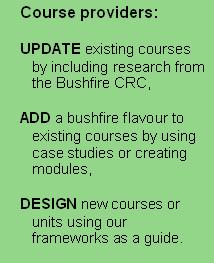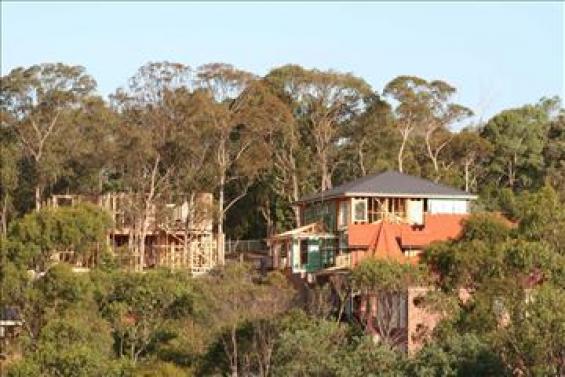Planning, Architecture, Surveying, Engineering
Town planners, architects, builders, surveyors and engineers play a key role in land use development in areas that are prone to bushfire.
Whether designing a single dwelling, a subdivision, or zoning land for development, professionals need a solid understanding of how to create safe and sustainable environments.
Ongoing changes in legislation has put a greater onus on developers and planners. NSW is the first state where developers need to meet legislative requirements for new building proposals so that they are deemed safe for a Fire Danger Index of 100. A new national Building Code for building in bushfire prone areas is expected to be in place by May 2010.
 Higher Education courses in planning, architecture, surveying, building and engineering play an important role in building the capacity of students and professionals to meet these legislative requirements. Further, the development of a deep understanding of the underlying principles give graduates the freedom to find alternative solutions that still meet the intentions of the planning guidelines.
Higher Education courses in planning, architecture, surveying, building and engineering play an important role in building the capacity of students and professionals to meet these legislative requirements. Further, the development of a deep understanding of the underlying principles give graduates the freedom to find alternative solutions that still meet the intentions of the planning guidelines.
The following diagram shows seven key perspectives that a course designer might consider in developing well grounded understandings and practical skills in planning and design in bushfire prone areas. These perspectives aim to give a sense of the whole, rather than be clearly demarcated categories.

How to use framework
A lecturer in planning might draw on all seven perspectives to ensure students gain a big picture understanding of the competing issues. Students would develop deep principled understandings, knowledge of the interconnections and a capacity for informed decision making.
A lecturer in engineering might be primarily interested in the building design perspective - how particular construction designs and materials act under fire. They would likely draw on understandings of fire behaviour related to intensity of fire and radiant heat. They might be interested in the modeling of fire behaviour in and around structures.
Potential Students
Undergraduate Students
Participating in undergraduate degrees in planning, architecture, surveying, or engineering.
These students are preparing for challenges that they need to face in the next 5 to 10 years in which prospective employers will expect them to have the skills to meet. They need to gain principled understandings that are transportable across states. They need to develop understandings that are embedded in current courses rather than be expected to do "top up" courses.
Graduate Students
Grad Dip / Grad Cert - Planning
Completed degrees in environmental or earth sciences, law, social sciences.
These students are looking for a vocational qualification that can lead to specific employment as planners. They bring varied backgrounds. They are looking for something that is valued by employers and can meet the challenges of the next 5 to 10 years. They need to develop generic understandings that are transportable across states.
Existing Professionals
Planners, architects, builders, surveyors, engineers
These professionals are already working in areas where bushfire is an issue and are looking at gaining understandings that can help them deliver community and client-based solutions. They are likely to be members of their professional organisations (such as PIA, RAIA) which have Continuing Professional Development schemes. They are looking for tailored short courses which can be acredited against these schemes and which enable them to develop understandings in context with their local situations.
Bushfire Design Consultants
This is a growing group of people who provide advice to building surveyors, architects and planners, householders, local government and communities. They need to be accredited with the Fire Protection Association of Australia (FPAA). They have varying backgrounds - many coming from fire services and some with environmental, planning or surveying backgrounds. This group are likely to be interested in building their capacity where they have gaps in their previous experience.
Two paradigms on community safety
There are two key paradigms which inform the development of community safety policies around bushfires (Handmer 2008). The predominant paradigm is centred on the issue of fire - its impact on assets, the environment, people and their activities. It focusses on a management approach.
The other paradigm comes from a more social perspective. It seeks to understand the capacity and limitations of people to adapt to fire. It is interested in understanding the history and rationale of settlements, how and why people build. It looks at building community profiles and looking at ways of developing community capacities.
The following diagram indicates how these two paradigms might inform the thinking of architects, surveyors, planners and land managers whether building a single dwelling, planning a subdivsion, planning for a whole community, or managing the landscape.




